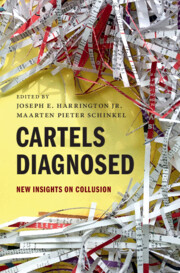Book contents
- Cartels Diagnosed
- Cartels Diagnosed
- Copyright page
- Contents
- Figures
- Tables
- Contributors
- Introduction
- 1 Entry Barriers, Personal Relationships, and Cartel Formation
- 2 “Now You Are Asking for a Real War!”
- 3 Coordinating Fuel Surcharges
- 4 Price Fixing or Fixing Competition?
- 5 The Role of Platforms for Facilitating Anticompetitive Communication
- 6 Collusion with Non-express Communication
- 7 Cartel Instability and Price Wars
- 8 Coordinated Rebate Reductions and Semi-collusion
- 9 Average Bid Auction Format Facilitates Bidding Rings
- 10 The Challenges of Cartelization with Many Products and Ongoing Technological Advancements
- 11 Two Cartels in the Supply Chain
- 12 Is it Collusion or Competition behind Price Parallelism?
- References
11 - Two Cartels in the Supply Chain
Raw Tobacco in Spain*
Published online by Cambridge University Press: 06 December 2024
- Cartels Diagnosed
- Cartels Diagnosed
- Copyright page
- Contents
- Figures
- Tables
- Contributors
- Introduction
- 1 Entry Barriers, Personal Relationships, and Cartel Formation
- 2 “Now You Are Asking for a Real War!”
- 3 Coordinating Fuel Surcharges
- 4 Price Fixing or Fixing Competition?
- 5 The Role of Platforms for Facilitating Anticompetitive Communication
- 6 Collusion with Non-express Communication
- 7 Cartel Instability and Price Wars
- 8 Coordinated Rebate Reductions and Semi-collusion
- 9 Average Bid Auction Format Facilitates Bidding Rings
- 10 The Challenges of Cartelization with Many Products and Ongoing Technological Advancements
- 11 Two Cartels in the Supply Chain
- 12 Is it Collusion or Competition behind Price Parallelism?
- References
Summary
◦ The Spanish raw tobacco market offers a story of two cartels that operated simultaneously. The first cartel operated on the seller side of the market. It was set up by the three agricultural unions that managed contract negotiations for the tobacco producers (“the producer representatives’ cartel”). The second cartel, on the buyer side, was formed by the purchasers of raw tobacco (“the processors cartel”).
◦ The case study tells a rich story of cartel formation. Government regulation sought to establish fair prices for tobacco producers through a system of production quotas. This led those producers to form a cartel to collectively negotiate with downstream tobacco processors. The processors formed their own cartel to counterbalance the one upstream. We then have regulation inducing one cartel which then inspires a second cartel.
◦ The processors’ cartel exemplifies some of the challenges in achieving effective collusion as well as the critical complementary role of monitoring and punishing mechanisms. The cartel was ineffective in its first two years in spite of a high level of market concentration and effective monitoring. Only when an internal compensation mechanism was put in place did firms comply with the collusive outcome.
- Type
- Chapter
- Information
- Cartels DiagnosedNew Insights on Collusion, pp. 317 - 341Publisher: Cambridge University PressPrint publication year: 2025

